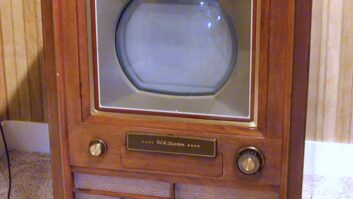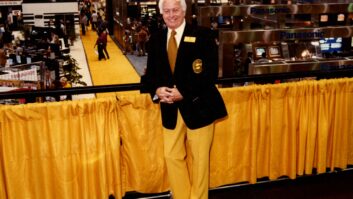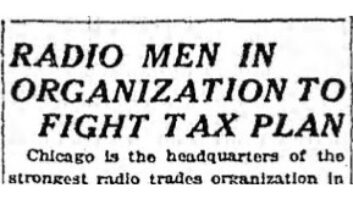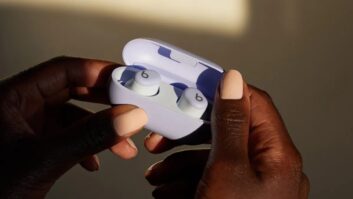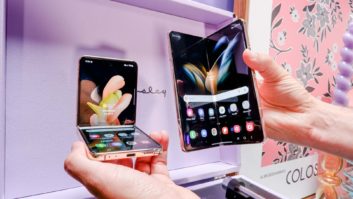
This year marks the 100th anniversary of the founding of the CTA (Consumer Technology Association), which started out as the RMA (Radio Manufacturers Association). This is the fourth in a series of essays exploring and celebrating CTA’s and our industry’s first century of invention, innovation, and entrepreneurship, assembled from varying technology historical research and writings I have done over the course of 20-plus years, including from an annually updated industry history for CTA’s now-defunct Digital America, 20-plus years of CTA Hall of Fame inductee biographies, and numerous tech history articles for a variety of publications over the years.
Read Part 1: Founding here, Part 2: David Sarnoff here, and Part 3: The TV Age here.
We finally enter a time period – the alternately celebrated and reviled Sixties (okay, Boomer!) – in which there is widespread vivid human memory of times, events, and people, even if those memories tend to be heavily and nostalgically rose-hued.
In the real world, the 1960s was a period of societal and political disruption: the Vietnam War, the Civil Rights movement, the Space Race, the Missiles of October, the assassinations of Malcolm X, JFK, Martin Luther King Jr., and RFK, the Vietnam War, the Women’s Rights movement, hippies, yippies and Woodstock, a presidential resignation – oh, did we mention the Vietnam War?
Technologically, the 15 years encompassing 1960 to CTA’s 50th anniversary in April 1974 was dominated by the Space Race, which resulted in satellite communications and other technology breakthroughs, especially miniaturization, the rise of home stereo, the invention of LCD and the LED, the commercialization and spread of the computer, and Philips’ invention of the compact audio cassette, which would inspire the invention of the video cassette.
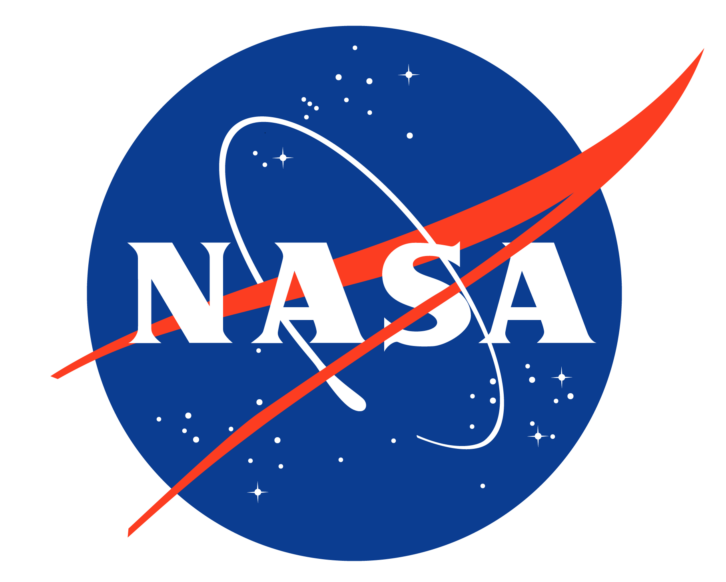 But perhaps the most critical result of the Space Race was not necessarily new technology, but the generation of consumer electronics engineers it spawned. A large percentage of the Consumer Technology Hall of Fame inductees whose biographies I have written cited either their experience working directly with or for NASA, their work for a NASA subcontractor or other space-related company or were inspired to pursue engineering because of the Space Race much like a generation of future rock stars were influenced to pick up guitars and start bands after seeing The Beatles on Ed Sullivan in February 1964. Without this multi-generational flow of space-inspired engineers, we would not enjoy the bulk of the technologies currently filling our homes, cars, and pockets.
But perhaps the most critical result of the Space Race was not necessarily new technology, but the generation of consumer electronics engineers it spawned. A large percentage of the Consumer Technology Hall of Fame inductees whose biographies I have written cited either their experience working directly with or for NASA, their work for a NASA subcontractor or other space-related company or were inspired to pursue engineering because of the Space Race much like a generation of future rock stars were influenced to pick up guitars and start bands after seeing The Beatles on Ed Sullivan in February 1964. Without this multi-generational flow of space-inspired engineers, we would not enjoy the bulk of the technologies currently filling our homes, cars, and pockets.
I’m devoting the bulk of this chapter – and forgive the length – to three topics: the rise of Asian companies in our business, the retail changes within our industry, and the technology seeds planted during the 1960s and early 1970s for products that bountifully bloomed in the last quarter of the 20th century.
An international Industry
Just as it did in society in general, the Sixties brought dramatic change to the consumer electronics industry, but not much in terms of product mix. In 1974, the industry consisted largely of four major products, largely unchanged from the chronological start of the decade: TVs, radios, record players, and the industry’s newest gadget, audio cassette tape player/recorders.
Sales of consumer electronics during the decade, however, boomed. Revenue from consumer electronics in 1960 was a smidge over $2 billion dollars (nearly $21 billion in 2024). By the end of the decade, the industry garnered $5.3 billion in sales (nearly $44 billion in 2024). Between 1963 and 1968, sales of consumer electronics more than doubled, perhaps coinciding with the first televised war, TV coverage of the civil rights movement, and the re-birth and spread of rock ‘n’ roll music from such diverse locales as Detroit, San Francisco, Alabama, Newport, and especially Britain.
But it was not what or how much consumer electronics devices were sold between 1960-1974, but where they were made that was the biggest change in the industry during this turbulent period.
Matsushita
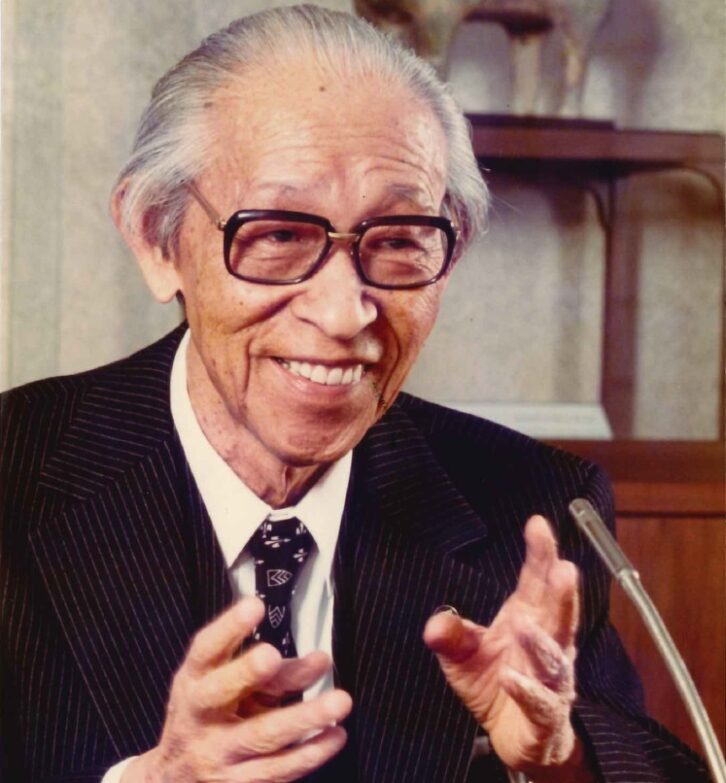
Learning from the retributive and economically repressive 1919 Treaty of Versailles which was a direct cause of World War 2, the U.S. decided to invest, rebuild, and transform its former enemies into friends. A rebuilt Germany became known for its cars and high-end cameras. Japan started churning out lower-priced cameras and consumer electronics.
In 1960, only 2,000 imported TVs were sold in the U.S. By 1969, nearly 2 million of the 13.3 million TVs sold in the U.S. came from outside the country, largely Japan. In 1960, 7.5 million of the 24.4 million radios sold in the U.S. were imported; in 1969, imported radios reached 29 million units, the first time non-U.S.-made radios topped 50% of all radios sold. Obviously, this shift from domestic to Asian manufacturing and branding would only expand to dominate the industry.
American and global store shelves dominated by familiar American electronics brands as RCA, Zenith, Admiral, Westinghouse, GE, Emerson, Motorola, and Philco, were soon being filled with largely less expensive if not downright cheap alternatives bearing unfamiliar brand names such as Aiwa, Hitachi, Kenwood, Pioneer, Sansui, Sharp, Sanyo, and Toshiba.
Arguably the two leading Japanese companies in the 1960s and 1970s were Matsushita – which housed primarily the Panasonic and JVC brands – and Sony. Over the next two decades, both these companies would first challenge, sometimes aid, and finally usurp RCA and Zenith as the industry’s leading companies.
Matsushita was founded by Konosuke Matsushita (1894-1989) in 1918 as a shop selling an electric light socket he designed, three employees, and about $50 in capital. The first socket failed, but Matsushita’s next electric attachment plug undersold his competitors for 30 percent. After WW2, Matsushita Electric then supplied “three treasures” to recovering Japanese households: a washing machine, a refrigerator, and a black-and-white television.
In 1961, Konosuke Matsushita essentially handed over control of the company to his son-in-law, Masaharu Matsushita (1912-2012), who was responsible for establishing the company as a global brand.
In 1959, Ray Gates (1920-2023) became Matsushita’s first American employee, named president of the company’s U.S. sales and marketing subsidiary. Because of a copyright problem, however, Matsushita could not use its Japanese brand name, National, in the U.S. Gates suggested the name Panasonic – essentially Latin for all-encompassing sound.
At the time, the entire Panasonic line of radios, transceivers, and battery tape recorders, could fit inside a briefcase. Gates began manufacturing goods at a clock radio and stereo plant in Puerto Rico in 1965. Over the next 25 years of his leadership, Gates built Panasonic, along with its Technics and Quasar branded products, to enable Matsushita to become the world’s biggest consumer electronics maker.
Sony
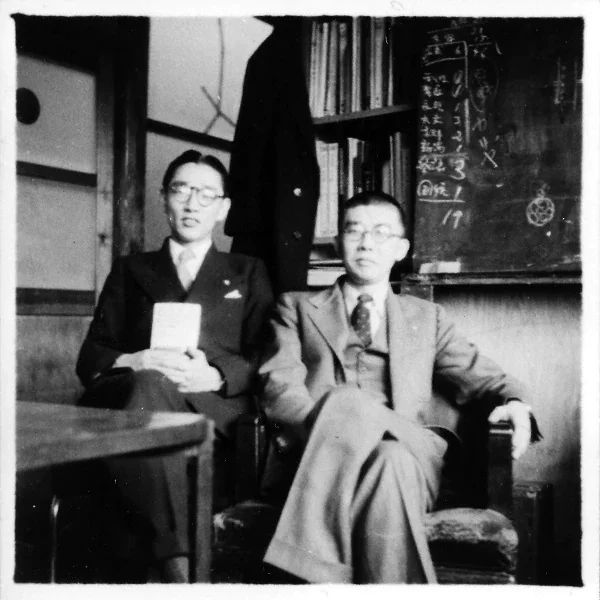
Sony began in even more humble circumstances. An enthusiastic radio ham from an early age, Masaru Ibuka (1908–1997) studied electrical engineering, graduating from Waseda University in 1933. During WW2, Ibuka managed a measuring instruments company and also took part in a research project on heat-seeking missiles where he first met a young engineer named Akio Morita (1921–1999).
In September 1945, right after the end of WW2, with $500 Ibuka founded a radio repair company with seven employees paid out of Ibuka’s meager savings, established in a bleak, windowless office on the third floor of the heavily damaged Shirokiya Department Store.
After some initial success, in May 1946, the company transformed into Tokyo Tsushin Kogyo, or the Tokyo Telecommunications Engineering Corporation, dubbed Totsuko. Ibuka hired Morita as the company’s managing director after the pair became reacquainted. The company made a variety of commercial and industrial electronic products including a rice cooker and an electric heat cushion. Then, as the company rapidly grew, the company developed Japan’s first audio tape recorder in 1950, marketed under the name SONI-TAPE.
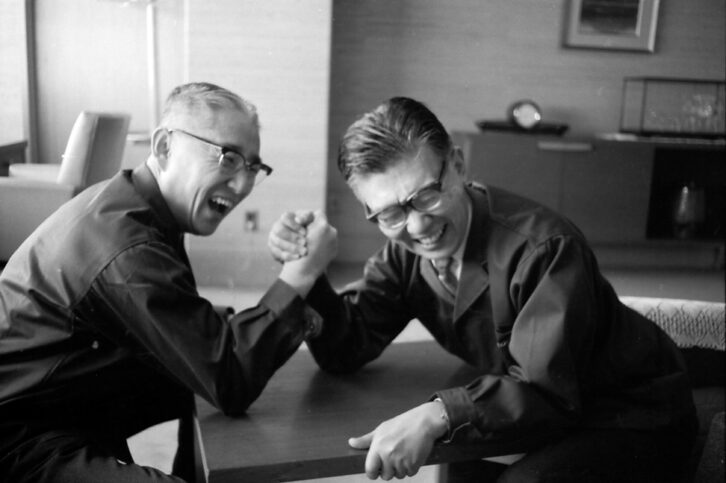
In 1952 and 1953, first Ibuka then Morita visited the U.S. to investigate the possibilities of the transistor. After acquiring licensing rights from Western Electric, company engineers started working on a pocket-sized transistor radio. But Ibuka and Morita discovered Americans could pronounce neither Tokyo Tsushin Kogyo nor Totsuko, so chose the simpler “Sony” – a diminutive of “sonic” – as the company’s new brand name. In August 1955, Sony launched its U.N.-building shaped TR-52 transistor radio in the U.S., which launched Sony as a brand and boosted the Japanese consumer electronics industry worldwide.
Building on the success of its transistor radios, in 1960, Sony Corp. of America, the first Japanese company to list its shares on Wall Street, was established. A series of innovative and “first-ever” products soon started flowing, including the first direct-view transistor TV set in 1960, the first solid-state videotape recorder in 1961, and, in 1968, the Trinitron color TV, which would soon help transform Sony into the world’s leading seller of TVs. In the subsequent decades, Sony would launch the video revolution with the Betamax in 1975, the personal audio age with the Walkman (1979), the digital audio age with the compact disc (with Philips) in 1982, would nearly monopolize the video game market with the Sony PlayStation (1994), and co-invent the digital video age with the DVD (with Philips, Toshiba, and Matsushita) in 1996.
The Consumer Electronics Retail Revolution
While who and where consumer electronics were made was subtly shifting in the 1960s, so was who and where consumers could buy their TVs, radios, and record players. Mostly, we bought our gadgets at locally owned mom-and-pop stores, some of which grew into large regional chains.
For instance, in 1936 in Chicago, David and Jewel founded Abt Radio, now the dominant appliance and consumer electronics store in the Midwest (at least), and one of the early online retailing pioneers. In New York City in 1947, A.J. Richard took over his father’s hardware store business and turned it into a 49-store consumer electronics chain during the next 50 years and, in 2009, even took over closed Circuit City stores.
In 1951, Sidney Cooper turned his door-to-door electronics installation business into the brick-and-mortar Silo store in Philadelphia, eventually growing the business to 40 stores in several states. In 1953, C.W. Conn joined his father’s Beaumont, Texas-based appliance retail operating, and over the subsequent four decades built the state’s largest consumer electronics retail chain.
But it was the owner of a Texas retail crafts chain who became the unlikely consumer electronics national retailing change agent.
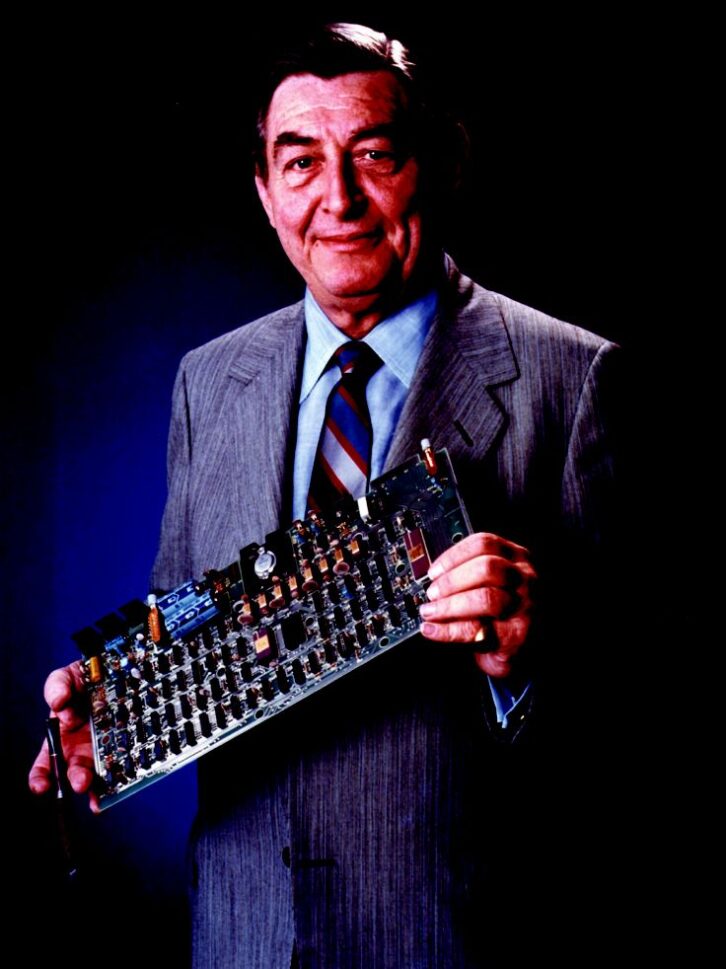
Starting with two retail leather stores opened with his father in the 1950s, by 1960 Charles Tandy had built a 119-store chain of craft stores under the Tandy Leather Company name. Tandy soon began searching to expand beyond leather and crafts, however. In 1963, he came across a failing nine-store Boston-area consumer electronics retailer that had reported losses of $4.5 million, owed $57 million, and had a negative net worth of $2.5 million.
Tandy didn’t think the business was bad but that its management was, and proposed spending $300,000 to buy the struggling chain. His board naturally thought Tandy was certifiable. Tandy defied his board and bought the Radio Shack chain anyway.
Tandy closed Radio Shack’s larger stores and opened smaller 2,500-square-foot locations that he leased so he could quickly close underperforming locations. He decimated the number of SKUs each store sold, concentrating on the 20 percent of the items that represented 80 percent of its sales. He used the company’s mail order list to determine the most fertile retail locations. He sourced all the chain’s products from Japan and championed private labeling, resulting in the soon-to-be ubiquitous Realistic, Archer, Micronta, and Optimus brands.
Growth was explosive. By the end of 1964, Radio Shack had expanded to 43 locations in 13 states. By the end of 1965, there were 74 stores in 20 states. A year later there were around 130 stores, and more than 100 stores were added each year.
After suffering a heart attack in October 1968, Tandy moved Radio Shack’s HQ from Boston to Tandy’s home base in Fort Worth. Tandy’s purchase of Allied Radio expanded Radio Shack’s retail base to more than 1,000 locations by the spring of 1971. Every downtown, every small strip mall, every major mall seems to include a Radio Shack. In 1973, Tandy began opening hundreds of locations around the world, growing to 7,000 outlets worldwide generating annual sales of more than $1.2 billion. By the time Tandy died at age 60 on November 4, 1978, he had transformed Radio Shack into the world’s most dominant, ubiquitous, and influential consumer electronics retailer, which provided a training ground for a generation of consumer electronics executives.
Radio Shack’s success inspired other visionary retailers during the 1960s and early 1970s. In 1966 in St. Paul, Minnesota, Richard Schultze founded the Sound of Music, which would evolve into Best Buy in 1983, the first so-called “big box” electronics superstore. In 1967 in Seattle, Len Tweten added hi-fi gear to his stationery and camera store and, under his son Jim’s leadership, created the nationwide Magnolia Hi-Fi chain.
In 1969 in San Diego, stereo salesman Mike Romagnolo decided to go into business himself with DOW Stereo, which would become the premier retail launching pad for nearly all new audio and video formats in the 1980s and 1990s. In Philadelphia in 1968, Robert Cole abandoned a career in clinical psychology and founded the area’s now dominant World Wide Stereo A/V chain. In Los Angeles in 1970, Wilfred Schwartz bought a 25,000-square-foot warehouse from a floundering electronics firm and turned it into Federated, which soon grew to more than five dozen stores and would dominate Southern California electronics retailing for 20 years.
CES
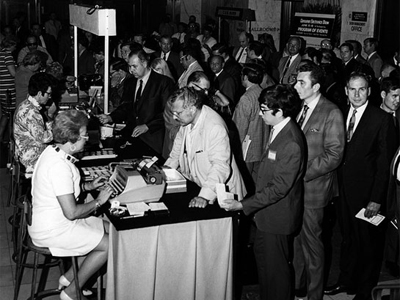 CES 1967 Registration: In 1967, what would become CTA was then the Consumer Products Division, just one sector within the sprawling Electronics Industries Association (EIA). With no industry-sponsored event, most CE vendors exhibited at a number of other, largely inappropriate, trade shows, primarily the Music Show sponsored by the National Association of Music Merchants (NAMM). In mid-1966, CPD staff VP Jack Wayman convinced the EIA board of the need for a specialty “consumer electronics show” to shine a brighter light on the industry.
CES 1967 Registration: In 1967, what would become CTA was then the Consumer Products Division, just one sector within the sprawling Electronics Industries Association (EIA). With no industry-sponsored event, most CE vendors exhibited at a number of other, largely inappropriate, trade shows, primarily the Music Show sponsored by the National Association of Music Merchants (NAMM). In mid-1966, CPD staff VP Jack Wayman convinced the EIA board of the need for a specialty “consumer electronics show” to shine a brighter light on the industry.
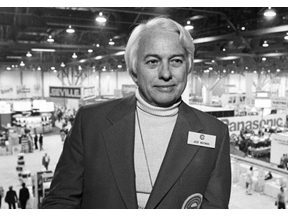
Over at EIA in the mid-1960s, consumer products comprised only 19.5% of electronics factory sales, with government products totaling 49.1% and industrial products reaching 29%. With such a diversity of commercial, industrial, and consumer electronics products, there were no EIA trade shows. Consumer electronics makers were forced to exhibit their wares to the trade at other usually inappropriate industry trade shows, primarily the Music Show, run by the National Association of Music Merchants (NAMM) – the musical instrument business.
But with consumer electronics sales booming, consumer electronics companies such as RCA and Zenith began to dwarf the entire musical instrument industry. A variety of consumer electronics companies lobbied NAMM for a more representative presence at the Music Show, to no avail.
An industry-specific consumer electronics show was obviously needed. So in mid-1966, Consumer Products Division VP Jack Wayman convinced the EIA board to sponsor one.
Rather than spend time here detailing that first CES, held in New York, then the center of the TV and hi-fi business, on June 25-28 1967 at the New York midtown Hilton and the Americana, now Sheraton, hotels, allow me to direct you to a more extensive history I wrote for Sound & Vision, and to a photo gallery that TWICE ran on the inaugural show’s 50th anniversary.
One little-known story from that first show is the panic RCA suffered that nearly all subsequent CES exhibitors have experienced in one form or another and can thoroughly relate to.
Two days before the show’s Sunday opening ribbon cutting, trucks containing an estimated half million dollars of gear to be displayed at the show by RCA were literally hijacked. Two gunmen entered the Manhattan warehouse where the trucks were parked, chained the two guards, and drove off with a half million dollars worth of TV sets, stereos, and other new gear and pre-production samples. It took two hours before the guards were able to free themselves and summon help.
William King, RCA’s exhibits manager and chairman of EIA’s Show Committee, worked late into the night with other RCA officials to round up substitutes for the stolen goods. Some replacements were trucked in from RCA facilities in Bloomington and Indianapolis, IN, and others shipped in at the last minute from a just-ending dealer open house in Wilkes-Barre, PA. “RCA is the real demand line,” King quipped at the time. “The only line demanded at gunpoint.” Even though the FBI was called in, RCA’s hijacked gear was never recovered, and the perps were never caught – but RCA somehow managed to open its booth on time for the show’s opening without no one the wiser.
An estimated 17,500 manufacturers, distributors, and retailers checked out 100 exhibits occupying 150,000 square feet over the four hotel locations, viewing 10,000 products ranging “from $8 radios the size of a pack of cigarettes to $15,000 room-length stereophonic units,” according to coverage of the show in The New York Times.
CES would be held at the same hotel venues in New York City during the next three summers before moving to a rebuilt McCormick Place in Chicago in 1971. The modern era of CES began in 1978 with the first winter show in Las Vegas. Each year, CES grew in attendees, exhibitors, floor space, industry importance, and market prestige. In January 2017, the 50th anniversary of CES, a record 3,800-plus exhibitors and a record 170,000-plus attendees overwhelmed Las Vegas.
Technology Seeds
As noted, when EIA celebrated its 50th anniversary in April 1974, the consumer electronics industry comprised just four product categories, three of which had been around for decades: television, radio, phonograph, and still new-fangled audio tape, primarily the now familiar Philips compact cassette which debuted in 1966.
Over the subsequent 25 years, the number of consumer electronics products and technology categories multiplied like – well, like the number of transistors on a microchip – including home video recording, personal music, home computers, the internet, video games, digital cameras, smartphones, GPS, and flat screen TVs. All tech we now can’t imagine how we lived without was unknown in the late 1960s and early 1970s. But the foundation for nearly all of today’s ubiquitous gadgets and technologies was laid in the relatively brief 15 years between 1960 and 1975. Here’s a brief list of developments during the period between 1960-1975 that would become ubiquitous by the end of the 20th century.
For instance:
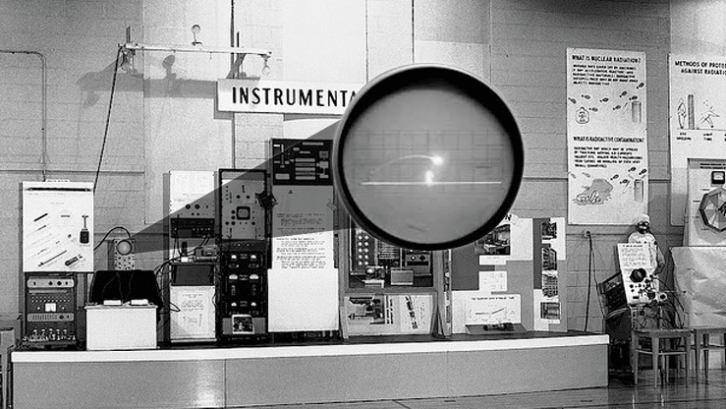
Video Games: In October 1958, Brookhaven National Lab researcher Willy Higinbotham built the first video game, a tennis-like ball-and-paddle game, using a computer and CRT screen display – an oscilloscope – for the Labs’ annual public exhibition. In February 1962, the same month John Glenn became the first American to orbit the Earth, 25-year-old Steve Russell and a group of MIT researchers programmed Spacewar, an interactive computer shooting game designed to be played on huge mainframe computers. But like Higinbotham, Russell and his MIT programmers created their games as academic experiments, so neither patented nor copyrighted their games or ideas.
In 1966, Loral researcher Ralph Baer, with a bit more foresight, patented a ball-and-paddle game designed to be played on a home television, which he licensed to Philips’ Magnavox. In September 1972, Magnavox introduced the first home videogame console, the Odyssey, which came with six video game cartridges, including Baer’s original Tennis game, launching the video game revolution.
LCD: What kept TVs, computers, and other screen-based devices anchored to desktops were their bulky and heavy cathode ray tubes. What was needed was a new lightweight screen technology that didn’t use a lot of power. The solution was liquid crystal display (LCD).
Liquid crystals were first discovered in 1888 by Austrian botanist Frederich Reinitzer, but the idea that they could be used in a display was first suggested in a 1963 paper by RCA researchers Richard Williams and George Heilmeier. In 1968, Heilmeier’s RCA group succeeded in producing the first stable experimental liquid crystal display panels.
But RCA’s LCDs consumed too much power. In 1967, Kent State University scientist James Fergason discovered the “twisted nematic” LCD and produced the first practical LCD panels in 1969. Working independently, Swiss-based F. Hoffmann-La Roche researchers Martin Schadt and Wolfgang Helfrich also invented the twisted nematic (TN) LCD in 1971. Hoffman-LaRoche later purchased Fergason’s patents.
The first LCD products were for watches and calculators in the early 1970s. But it would take several decades before large enough LCDs could be economically used to make affordable large flat TV screens.
Digital Imaging: Quite often, scientists and engineers searching for one thing end up with something completely different. In early October 1969, Willard Boyle and George Smith, physicists in the Semiconductor Components Division at Bell Labs, were researching new memory chip concepts for data storage.
After multiple sketches and erasures, the pair ended up designing a silicon circuit device that could transform light into electrical information – in other words, images – record that information, and then reconstruct and reproduce the information. Because the device moved an electrical charge around by coupling potential wells, Boyle suggested calling their creation a “charge-coupled device,” or CCD. In short order, the pair wrote up their invention in a paper, published in the Bell System Technical Journal on January 29, 1970, and completely changed the course of image capture and reproduction.
GPS: After the Russians launched Sputnik in 1957, Ivan Getting, VP of research at Raytheon, promoted the idea of using a system of satellites to track any moving object on the ground. Several competing ideas to Getting’s emerged, and battling projects caused military paralysis along with several project cancellations and rejuvenations until the third in command at the Department of Defense, Dr. Malcolm R. Currie, a fan of the project, finally authorized a joint services development effort led by an enthusiastic 37-year-old Air Force colonel and MIT and Stanford graduate named Dr. Bradford Parkinson.
Over the 1973 Labor Day weekend, Parkinson holed up with a dozen engineers from the varying military branches and several universities in the Pentagon. By Monday morning, the bleary-eyed group had produced a seven-page joint paper describing what would eventually become today’s GPS system. But, like these other seeds, it would take years before this military tech filtered down to consumers.
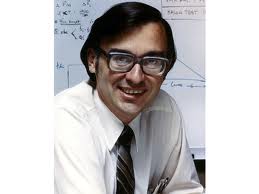
The Microprocessor: First there was the transistor. Then came the microchip. But what would the computer needed was a more complete and integrated chip. Intel employee number 12, Marcian E. “Ted” Hoff, led a two-year engineering effort that resulted in the development of the first microprocessor memory chip, the 4004, a 4-bit, 740 kHz engine comprised of 2,300 transistors, in 1971, the first “computer on a chip.” The following year, Hoff assisted other Intel engineers toward the development of the eight-bit 8008 chip and, in 1974, what was considered the first all-purpose microchip, the 8080.
The Internet: Today’s World Wide Web is just one part of the Internet, the development of which began in 1969 by ARPA (Advanced Research Projects Agency), later renamed DARPA (Defense Advanced Research Projects Agency), founded by the U.S. Department of Defense in 1957 in the wake of the Russians launching Sputnik. The idea of ARPAnet was to create a decentralized digital communications network that could not be disrupted by the loss of a single or even multiple nodes during a potential war.
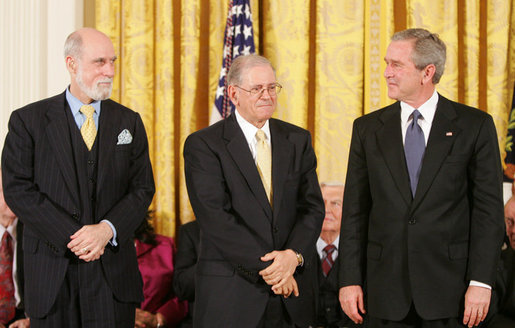
In a far less dramatic version of Alexander Graham Bell’s “Watson, come here, I need you!” moment, the first message sent over the ARPAnet Internet on October 29, 1969, was “lo” – UCLA Professor Leonard Kleinrock was trying to transmit “login” information to a colleague before the system crashed. Academia soon became the largest user of “the net,” with researchers linking up their computers to share data and communicating via electronic mail, or “e-mail.”
But it wasn’t until the mid-1970s that DARPA engineers Vinton Cerf and Bob Kahn developed TCP/IP (Transmission Control Protocol/Internet Protocol), the packet-switching protocols that form the foundation of how data is now moved around the internet, the creation of which earned the two the title of Fathers of the Internet. But since no consumer was yet using a computer outside an office, it would be years before the internet would become truly disruptive.
But in late 1968, we got a clue to our home computing future.
The Mothers of All Demos
Many of these technology seeds were individualistic, singular developments that lacked system context or didn’t resemble the consumer products or technologies they’d eventually evolve into.
But there were two daringly live public demos held during this period that presented a more-or-less complete view of our future digital communications-driven world that was at least a decade or more ahead of their time.
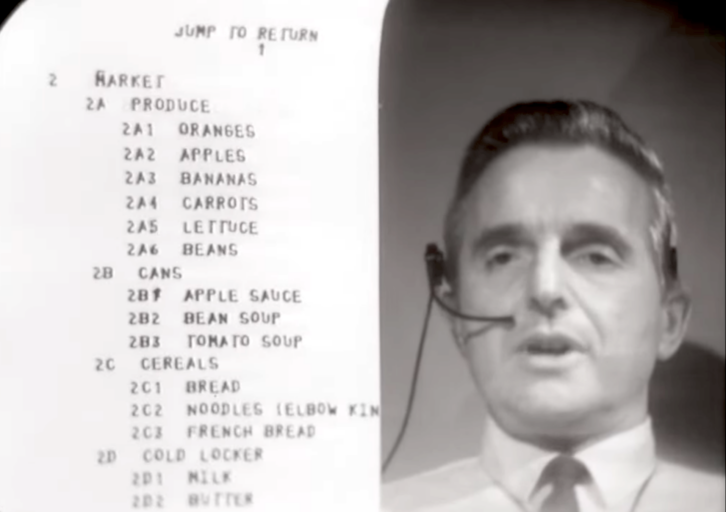
In the history of the consumer technology business, there have been a plethora of prescient engineers, but arguably none were more ahead of their time than Stanford Research Institute (SRI) researcher Douglas C. Engelbart. To make a long story short – and feel free to read my more complete history of this event here – on December 9, 1968, Engelbart led what has become known as “The Mother of all Demos.”
Over nearly two hours, Engelbart and his team calmly and patiently demonstrated a complete interconnected multi-location computer system with set-ups consisting of a keyboard, keypad, a graphic user interface that used frames on a screen called “windows” and allowed you to move words or graphical objects on the screen, a word processor, hypertext that allowed you to point-and-click on a word to produce another window with linked information, and a pointing device called a “mouse” that he had patented four years earlier to manipulate it all – all 15 years before the first GUI point-and-click home computer would appear and before the internet was perfected, and 25 years before the World Wide Web became available.
Luckily for posterity, the audacious “Mother of All Demos” was (presciently, of course) preserved and can be watched here on YouTube.
Can You Hear Me Now?
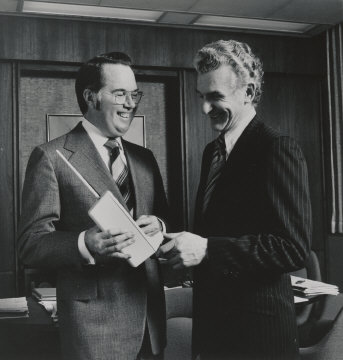
As I noted in Chapter 3 of this series, the idea for a honeycombed cellular telephone network was first laid out by AT&T researcher Douglas H, Ring in December 1947. But it took until the mid-1960s for an AT&T team led by Dr. Joel Engel and Richard Frenkiel to solve the vexing problem of maintaining calls as a user moved from one cell to another. Once call handoff was solved, AT&T submitted a proposal to the FCC on December 20, 1971, for the use of new 800MHz frequencies for this new cellular service that Ma Belle would naturally operate as both a service and hardware monopoly as it did landline telephone service.
At the time, Motorola held nearly two-thirds share of the car phone hardware market, a business that would disappear if AT&T gained its cellular monopoly.
Motorola needed a way to keep the FCC from awarding AT&T a cellular monopoly and not lose its entire business. In the fall of 1972, Motorola project manager Martin Cooper proposed a number of different communications systems using the new frequencies along with a portable cellular phone to illustrate that competition could result in improved innovation. Cooper and Motorola didn’t believe there was a credible market for portable phones outside the car. They weren’t even sure if such a portable phone small and light enough to carry, or even affordable, could be developed.
Cooper placed engineer Don Linder in charge of a crash engineering effort to develop a portable cellular phone. On April 3, 1973, Cooper, Motorola communications VP and GM John Mitchell, and Linder successfully demonstrated two hand-built units, each the size of a brick, dubbed the DynaTAC (Dynamic Total Area Coverage) for an astounded and visibly impressed press at New York’s midtown Hilton Hotel. The first call Cooper made during this press demo was to AT&T’s Engle, who later insisted on having no memory of the call.
The demo received the requisite press coverage, and may or may not have swayed the FCC. In all events, similar to these other technology seeds, it would take more than a decade of legal wrangling for the FCC to finalize the rules and allocations for cellular spectrum.
I’ve written a far more detailed and comprehensive, history of Motorola’s race to invent the cellular phone, “Hold the Phone,” which you can read here.
In our next chapter, we will explore how the society-shattering results of these technology seeds bloomed during what would become the most technologically disruptive period in history.
Significant Dates:
1960
- The first telephone-answering device, the Ansafone from Phonetel, goes on sale.
- First imported TVs go on sale in the U.S.
- Dr. Theodore Maiman builds the first working laser. (May 16)
- Echo, the first communications satellite, launches. (August 12)
1961
- FM Stereo radio broadcasting begins. (June 1)
1962
- David Paul Gregg, an engineer at 3M, files patent describing “electron beam” video recording on disc, which becomes basis for laserdisc. (March 21)
- Congress passes All-Channel Receiving Act requiring all-channel tuning (UHF and VHF) in television receivers. (July 10)
- The Telstar 1 communications satellite relays the first trans-Atlantic television signal – a baseball game between the Philadelphia Phillies and the Chicago Cubs from Wrigley Field. (July 23)
- Dr. Nicholas Holonyak, Jr., at GE demonstrates the first visible LED. (October 9)
1963
- Optical videodisc, the basis for today’s laserdisc and DVD, is demonstrated.
- LCD screen technology is suggested for the first time in a report by RCA researchers George Heilmeier and Richard Williams.
- Stanford researcher Douglas Engelbart builds the first computer “mouse.”
- Charles Tandy buys majority stake in Radio Shack for $300,000. (March 28)
- First version of American Standard Code for Information Interchange (ASCII) is published. (June 17)
- Nottingham Electronic Valve Company demonstrates the Telcan – television in a can – the first videotape recorder designed for home use. (June 24)
- Philips Electronics NV introduces the compact audiocassette. (August 30)
- AT&T inaugurates Touch-Tone service. (November 18)
1964
- Sony engineer Koichi Tsunoda proposes the videocassette.
- Bose founded by Amar Bose in Framingham, MA.
- AT&T demonstrates the futuristic Picturephone at the World’s Fair. (April 20)
- The first plasma display is built by Donald Bitzer, Gene Slottow, and Robert Willson at the University of Illinois at Urbana-Champaign. (July)
- The first commercial device with an integrated circuit, the Zenith Arcadia hearing aid, goes on sale. (October 4)
1965
- Audiovox founded by John Shalam.
- Revenue from sales of color televisions surpasses that of monochrome for first time.
- The first commercial telecommunications satellite, Early Bird (Intelsat 1), is launched. (April 6)
- Gordon Moore publishes paper describing “Moore’s Law,” predicting that the number of transistors on a chip would double every year. (April 19)
- Computer scientist Ivan Sutherland first describes the basic concepts of would become virtual reality. (May 24)
- Sony introduces the first portable and home consumer video recorders. (June 8)
- Eight-track audio players are marketed for first time as option in 1966 model Fords. (September 15)
- Ray Dolby develops Dolby A, first noise reduction system. (November 1)
1966
- Loral researcher Ralph Baer writes paper laying out video game concept. (September 1)
- James T. Russell of the Battelle Institute files patent for “Analog to Digital Optical Photographic Recording and Playback System,” forerunner of CD and DVD. (September 1)
- RCA becomes first network to produce all new TV shows in color. (November 7)
1967
- The first Consumer Electronics Show (CES) is held in New York at the Hilton and Americana Hotels. (June 25-28)
1968
- First imported color TVs go on sale in the U.S.
- The first dot matrix printer, the OKI Wiredot, is introduced.
- KLH’s Model 40 reel-to-reel tape deck, the first consumer device with Dolby B noise reduction, is introduced.
- The first stable LCD panels are developed and demonstrated by an RCA team led by George Heilmeier. (May 28)
- The Carterfone decision allows consumers to connect equipment to phones, allowing manufacturers to market telephone answering devices. (June 26)
- Intel founded in Santa Clara, CA, by Gordon Moore and Robert Noyce. (July 18)
- “Mother of All Demos” projecting future of computing, including hypertext, the computer mouse, networking, and graphic user interface (GUI), is conducted by Douglas Engelbart. (December 9)
1969
- Kent State University scientist James Fergason produces the first practical LCD panels.
- The first digital clock radio, the Sony Digimatic 8FC-59, aka “Digital 24,” goes on sale.
- First quadraphonic four-channel stereo tapes and players are marketed. (June)
- Charged coupled device (CCD) imaging chip is used in all future digital cameras and camcorders invented by Bell Lab physicists William Boyle and George Smith. (September 8)
- UCLA Professor Leonard Kleinrock transmits first message over ARPAnet, forerunner of the Internet. (October 29)
1970
- IBM files patent for computer floppy disk. (March 14)
- A Swiss patent is issued to Hoffmann-LaRoche in Switzerland for the first practical LCD technology. (December 4)
1971
- Electronic tuning is incorporated into U.S. TVs.
- Busicom LE-120A, the first “pocket” calculator, goes on sale. (January)
- Sony introduces U-Matic VO-1600, the first VCR and forerunner of Beta. (September)
- Intel announces its 4004 chip, the world’s first microprocessor. (November 15)
- RCA chairman David Sarnoff dies. (December 12)
1972
- Unit sales of color televisions pass monochrome for the first time.
- Pulsar introduces the PS1, the first all-digital watch. (April 4)
- Magnavox starts selling the Ralph Baer-designed Odyssey, the first video game console. (September)
- Motorola engineer Don Linder sketches out schematic of the first cellphone. (December 4)
1973
- Optel and Gruen start selling the first LCD watches.
- The first Winter Consumer Electronics Show (CES) is held in Chicago.
- Motorola executives Martin Cooper and John Mitchel demonstrate the first cell phone prototypes for the media. (April 3)
- PARC researcher Robert Metcalf circulates “Alto Ethernet” memo that describes how Ethernet will work. (May 23)
- Advent VideoBeam 1000, the first large-screen color projection TV, goes on sale. (August)
- Ethernet networking demonstrated for first time. (November 11)
1974
- International fax standard, Group 1, established.
- Philips begins process to buy Magnavox. (August 30)




